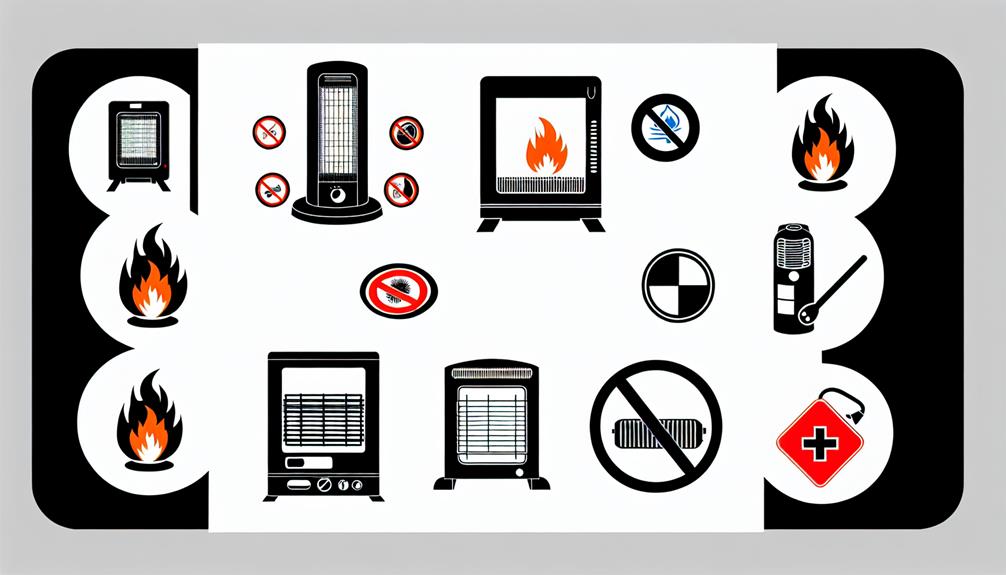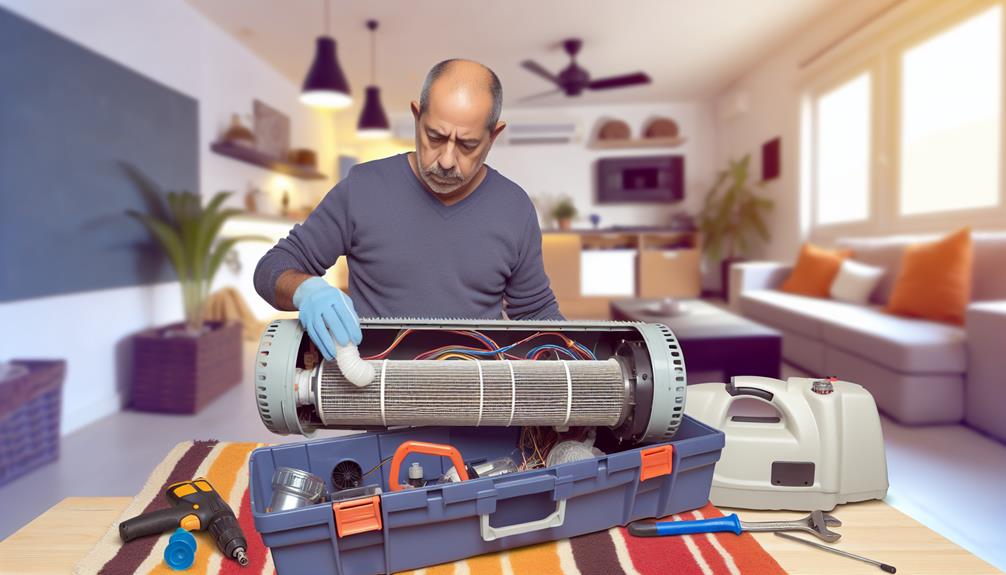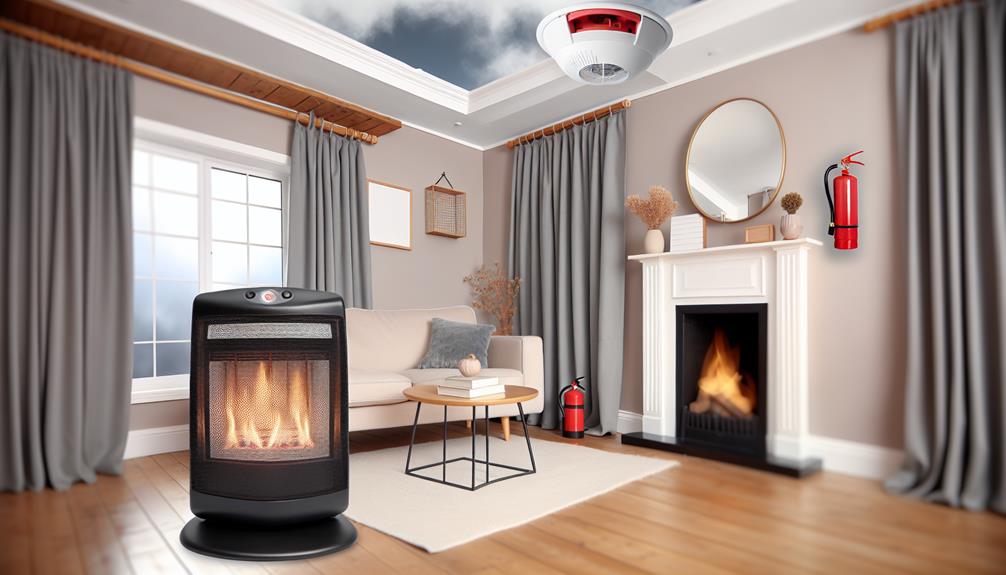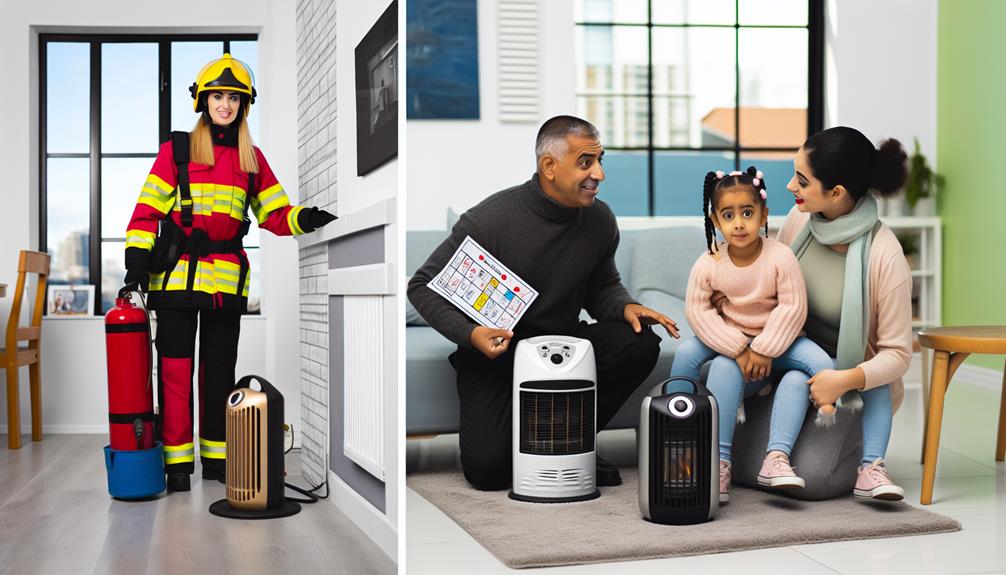Is it true that portable heaters—so often the cozy companions of chilly rooms—hide their risks behind a veneer of convenience? You've likely heard the cautionary tales, whispers of accidents and inefficiency, and it's no secret that these devices demand respect and understanding to ensure they're a benefit rather than a hazard. As you seek warmth, it's crucial to navigate the labyrinth of safety measures, from the intricacies of proper placement to the nuances of maintenance. It's not just about knowing when to switch it on; it's about the symphony of precautions that must harmonize to keep danger at bay. Let's begin to unravel the threads of safety protocols that stand between you and the silent threats that could be lurking in your harmless-looking portable heater, and find out just how prepared you are to use it safely.
Key Takeaways
- Understanding the different types of portable heaters, such as convection heaters, radiant heaters, oil-filled radiators, and fan heaters, can help in choosing the most suitable option.
- Assessing safety features like automatic shut-off functions, overheat protection mechanisms, tip-over switches, and thermostats is crucial for ensuring the safety of portable heaters.
- Proper placement and safe spacing of portable heaters, along with following ventilation requirements and maintaining constant airflow, are important to prevent fire hazards and carbon monoxide buildup.
- Selecting a stable, heat-resistant surface, following maintenance and operating instructions, and implementing fire prevention strategies are essential for safe and efficient use of portable heaters.
Understanding Portable Heaters

When selecting a portable heater, it's crucial to understand its types, mechanisms, and energy efficiency to ensure you choose a unit that suits your specific heating needs and safety requirements. Heater types vary widely, and each comes with its own set of features that impact performance and energy consumption.
Convection heaters, for instance, warm the air in a room by circulating it across a heating element. These heaters are typically energy-efficient for prolonged use in well-insulated spaces. On the other hand, radiant heaters emit infrared radiation that directly heats objects and people in their path, making them ideal for spot heating or poorly insulated areas.
Another popular option is the oil-filled radiator, which, despite taking longer to heat up, provides consistent warmth and is energy-efficient for extended use. Alternatively, fan heaters blow out heated air and warm up spaces quickly, but they can be less energy-efficient due to the continuous use of a fan.
Energy efficiency is a paramount consideration, as it directly affects your heating costs and environmental footprint. Look for heaters with programmable thermostats, multiple heat settings, and timers to better control usage and maximize efficiency. Some models also feature an Eco-mode, which optimizes power consumption based on the ambient temperature.
Safety features should not be overlooked. Opt for heaters with overheat protection, tip-over switches, and cool-to-touch surfaces to minimize fire risks and burn hazards. Additionally, ensure the heater you select is appropriately sized for your space to avoid overworking the unit, which can lead to inefficiency and potential safety hazards.
Understanding the nuances between heater types and prioritizing energy efficiency will lead you to a safe and cost-effective choice that aligns with your heating requirements.
Assessing Safety Features
When selecting a portable heater, you must prioritize models equipped with essential safety features. An automatic shut-off function is critical, as it ensures the heater turns off if it overheats or if operating conditions become unsafe. Moreover, overheat protection mechanisms and a tip-over switch are indispensable for preventing fire hazards and enhancing the safety of your home.
Automatic Shut-Off Function
Crucially, a portable heater's automatic shut-off function serves as an essential safety feature, swiftly powering down the unit if it tips over or overheats. This mechanism is not just a matter of convenience; it's a critical line of defense against potential fire hazards and electrical mishaps that could arise from improper cord management or energy inefficiency. Here's what you need to know:
- Automatic Shut-Off Function:
- *Tilt Protection:* Activates if the heater tips beyond a certain angle.
- *Overheat Sensor:* Cuts power when internal temperatures exceed safe limits.
- *Cord Safety:* Prevents overheating due to poor cord management, promoting energy efficiency.
Overheat Protection Mechanisms
Building on the importance of automatic shut-off functions, it's also vital to assess the robustness of a portable heater's overheat protection mechanisms to ensure your safety. You need to check for thermostat variability, which allows for precise temperature control and reduces the risk of overheating. Regular wiring inspections are equally crucial, as they help identify any potential electrical hazards that could compromise the heater's safety features.
| Feature | Purpose | Check Frequency |
|---|---|---|
| Thermostat | Regulates heat output | Seasonally |
| Auto Shut-Off | Prevents overheating | Each Use |
| Wiring | Ensures electrical safety | Annually |
Tip-Over Switch Importance
Understanding the significance of a tip-over switch is essential, as it's a safety feature that automatically turns off your portable heater if it's knocked over, reducing the risk of fire. This feature is not only a testament to heater durability but also serves as a usage indicator, alerting you to potential accidents.
- Heater Safety:
- *Tip-Over Switch:*
- Automatically shuts off power
- Minimizes fire hazards
- Essential for homes with pets or children
- *Heater Durability:*
- Extends the life of your heater
- Reduces wear from accidental falls
- Indicates robust design standards
- *Usage Indicators:*
- Alerts when the heater is not upright
- Helps maintain proper heater placement
- Encourages vigilant monitoring
Proper Placement Guidelines
When positioning your portable heater, you must ensure there's a minimum clearance of three feet from all combustible materials. It's essential to choose a stable, flat surface to prevent the heater from tipping over and causing a hazard. Always avoid placing heaters near curtains, bedding, or upholstered furniture to minimize fire risks.
Safe Heater Spacing
Ensuring your portable heater is positioned with ample space around it is crucial for both efficiency and safety. Different heater types have specific ventilation requirements that you must adhere to:
- Heater Types:
- *Convection Heaters:* Require at least three feet of clearance.
- *Radiant Heaters:* Keep combustibles at a minimum four-foot distance.
- *Oil-filled Radiators:* Maintain a two-foot perimeter free of objects.
- Ventilation Requirements:
- Ensure a constant flow of air to prevent carbon monoxide buildup.
- Avoid placing heaters in enclosed spaces without adequate ventilation.
- General Spacing Tips:
- Never place heaters under desks or in cramped corners.
- Always follow the manufacturer's guidelines for proper spacing.
Surface Selection Criteria
Selecting a stable, heat-resistant surface for your portable heater is as crucial as maintaining proper spacing to prevent fire hazards and ensure optimal performance. You need to ensure that the surface material is compatible with the intense heat your device emits. Heat distribution is a key factor in this choice; the surface should not only withstand high temperatures but also not disrupt the heater's functionality. Avoid placing your heater on uneven surfaces or on furniture that could catch fire, like a plush carpet or a wooden table. Instead, opt for ceramic tile, stone, or concrete—materials that can handle the heat without deforming or posing a fire risk. Remember, your safety hinges on these details, so don't overlook the importance of proper surface selection.
Maintenance and Upkeep

Regular maintenance is crucial for the safe and efficient operation of your portable heater, demanding attention to detail and adherence to the manufacturer's guidelines. Without regular checks and care, you might not only reduce your heater's lifespan but also compromise your safety. Let's break down the essential steps you should never skip:
- Filter Cleaning:
- A clogged filter can lead to overheating and reduced efficiency.
- Regular cleaning ensures optimal air flow and performance.
- Check your manual for specific instructions, as some filters are reusable while others need replacing.
- Cord Management:
- Inspect the power cord for any signs of damage or wear.
- Ensure the cord is not a tripping hazard or placed under rugs where it can overheat.
- Unplug the heater when not in use to prevent any electrical complications.
- General Upkeep:
- Wipe down the exterior with a damp cloth to keep it dust-free; avoid using harsh chemicals.
- Ensure the heater's vents are not obstructed.
- Store the heater in a dry place when not in use to prevent any moisture buildup, which could lead to electrical issues.
Operating Instructions
Before powering on your portable heater, it's imperative to familiarize yourself with the specific operating instructions provided by the manufacturer to guarantee both safety and efficiency. The user manual is your go-to resource for understanding the nuances of your device. It contains critical information about the installation process, usage, and features specific to your model. Don't overlook this essential step; it's not just about convenience, but about preventing potential hazards.
As you unpack the heater, inspect it for any signs of damage incurred during shipping. Any cracks or loose components can be hazardous. Follow the installation process meticulously, ensuring that the heater is placed on a level, non-flammable surface, away from any combustible materials. Remember, the location of your heater impacts not only its performance but also your safety.
The user manual will guide you through the control settings. It's likely to have a section on the meaning of various indicators and warnings. Pay attention to these details to operate the heater effectively. If it's equipped with a thermostat, learn how to set it correctly to maintain your desired temperature without wasting energy.
Additionally, the manual should outline the proper extension cord specifications if you need to use one. Using the wrong type can be a fire risk. It will also advise on the proper care and cleaning to ensure your heater's longevity.
Fire Prevention Strategies

To minimize the risk of fire, always keep your portable heater at a safe distance from flammable materials, such as curtains, bedding, and furniture. It's vital to be vigilant about where you place your heater to ensure it's not a fire hazard. Besides placement, there are several other precautions you need to take:
- Regular Maintenance
- Clean the heater's filters and vents to prevent dust build-up, which can ignite.
- Inspect the heater for any signs of damage or wear before use.
- Ensure the safety features, like automatic shut-off, are functional.
- Circuit Evaluation and Electrical Safety
- Have an electrician perform a circuit evaluation to ensure your home's wiring can handle the portable heater's energy consumption.
- Avoid using extension cords or power strips, which can overheat with high-wattage appliances.
- Always plug the heater directly into a wall outlet.
- Ventilation Considerations and Safe Operation
- Ensure the room is well-ventilated, especially if using a fuel-burning heater, to prevent carbon monoxide buildup.
- Turn off the heater when you leave the room or go to sleep.
- Keep children and pets away from the heater to prevent accidental contact.
Children and Pet Safety
Ensuring the safety of children and pets around portable heaters requires vigilant supervision and the use of protective measures. As a responsible caregiver or pet owner, you must understand that the combination of a portable heater's allure and the innate toy interaction from children or pet curiosity can create hazardous situations. Children are naturally inquisitive and may be tempted to touch, play with, or even attempt to climb on a portable heater, unaware of the dangers it poses.
To prevent accidental burns or fires, it's crucial to educate children on the risks associated with heaters and establish clear rules about keeping a safe distance. For added security, consider installing safety gates or barriers around heating devices to physically restrict access. Moreover, it's essential to secure the heater in a stable position to prevent it from being knocked over during playtime.
With pets, particularly those that are attracted to warmth, ensure that your portable heater does not become a nap spot. Place the heater in a location where pets cannot reach it, and monitor their behavior to discourage any close encounters. Some heaters come equipped with motion sensors or automatic shutoff features that activate when a pet gets too close—investing in such models adds an extra layer of protection.
Additionally, keep all objects, including pet beds, toys, and blankets, at least three feet away from heaters to prevent fire risks. Regularly inspect your heater for any signs of wear or damage, such as frayed wires, that could be exacerbated by toy interaction or pet interference. Your diligence in following these guidelines will ensure that both your children and pets can coexist safely with portable heaters in your home.
Emergency Response Planning

Have you considered what steps you'll take in the event that your portable heater causes an emergency situation? Being prepared is critical, and having an emergency response plan in place can significantly reduce risks to you, your family, or your colleagues. Let's delve into the essential components of a robust emergency plan.
- Evacuation Drills
- *Practice Regularly*: Conducting evacuation drills at least twice a year ensures everyone knows what to do in case of a fire or other emergency. Familiarize yourself with multiple exit routes from different rooms.
- *Assign Roles*: Designate responsibilities, such as who will assist young children, the elderly, or pets.
- *Safe Meeting Spot*: Establish a clear, safe location outside the building to meet up after evacuating.
- Emergency Contacts
- *List of Numbers*: Keep a list of emergency contacts, including the fire department, nearby medical facilities, and a designated out-of-town contact.
- *Accessible Information*: Make sure the list is easily accessible, perhaps attached to your refrigerator or saved in your phone.
- *Inform Everyone*: Ensure that all household members or coworkers know where the emergency contacts are and how to use them.
- Immediate Actions
- *Power Off*: Know how to quickly turn off your portable heater and cut power to the unit if safe to do so.
- *Extinguish if Possible*: If a small fire starts, use a fire extinguisher only if you've been properly trained and it's safe.
- *Leave the Area*: If the situation is beyond control, evacuate immediately and call for help.
Frequently Asked Questions
Can I Use a Portable Heater in a Bathroom or Other High-Humidity Space?
You shouldn't use a standard portable heater in a bathroom or high-humidity space. Instead, look for models with moisture resistance and safety features specifically designed for such conditions. These units will have protections against humidity and potential water contact, ensuring they operate safely without risking electrical hazards. Always adhere to manufacturer guidelines and use caution in wet environments to avoid accidents. Keep safety your top priority when heating these challenging spaces.
How Does the Use of Portable Heaters Affect My Home Insurance Policy?
Using portable heaters can impact your home insurance policy; insurers may view them as an increased risk. As a homeowner, it's your responsibility to inform your insurer about using these devices. Failure to do so could affect your coverage. Moreover, if your insurer considers the heater a significant risk, your insurance premiums could rise. Always check with your insurance provider for specifics, as this ensures you're covered and aware of any potential cost increases.
Are There Any Health Concerns Associated With Using Infrared or Propane Portable Heaters for Extended Periods?
You should be cautious using infrared or propane heaters for long periods. Carbon monoxide poisoning is a risk if they're not properly ventilated. Propane heaters especially need strict adherence to ventilation requirements to ensure your safety. It's crucial to follow the manufacturer's guidelines and install carbon monoxide detectors in your home to monitor air quality continuously. Neglecting these precautions can lead to serious health issues, so always prioritize safety.
Can I Power a Portable Heater With a Generator During a Power Outage, and if So, What Precautions Should I Take?
You can indeed power a portable heater with a generator when the lights go out, just like a lighthouse stands resilient against the stormy night. Ensure you've got the right generator sizing to handle the heater's energy demands. Also, never overlook ventilation requirements; like a chimney needs clear passage for smoke, your heater requires proper airflow to prevent dangerous fume accumulation. Stay informed, authoritative in action, and attentive to these crucial details for safe usage.
How Do I Responsibly Dispose of or Recycle an Old or Malfunctioning Portable Heater?
When your heater's lifespan ends, you've got to dispose of it responsibly. Don't just throw it out! Check local recycling programs for electronics; they'll often take it off your hands. If it's still working, consider donation options; charities or shelters might need it. Always cut the cord before disposal to prevent reuse of a faulty heater, and remember, you're helping prevent environmental harm by properly recycling electronic waste.
